

Camilla Valley Farm Weavers' Supply is pleased to offer hundreds of books on Fibre Arts related topics. Below (and at the other links above) are detailed descriptions for a subset of the books available. The full list of books can be found at:
Also note that occasionally books become unavailable or a new source for out of print books is located. While we will try to provide books out of our inventory and/or can order them from our suppliers, sometimes this may not be possible. We will advise if a situation like this exists when you place your order, or you can contact us and we will verify availability before you order.
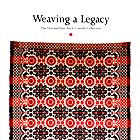
Weaving a Legacy - The Don and Jean Stuck Coverlet Collection
by Clarita S. Anderson
10 1/2" x 10 1/4" Hardcover (234 pages)
1995, Harry N. Abrams, Inc.
Nineteenth-century handwoven coverlets are exceptional windows on the early years of American culture. They are increasingly prized by collectors for their superb craftsmanship and beauty of design as well as their historical significance.
Produced by professional weavers, many of whom had fled the industrial revolution in Europe, coverlets were used as the uppermost coverings of beds. In addition to their intricate and colourful designs, many have personal inscriptions woven into their corner blocks or borders. The peak of production for handwoven coverlets was the relatively short period between 1820 and the end of the Civil War, when the weaving industry was rapidly becoming fully mechanized.
The Don and Jean Stuck Coverlet Collection at the Columbus Museum of Art is the largest public collection of Coverlets in the United States. The works of 185 known weavers are documented here, as are those of many anonymous weavers. With works from the nine most prominent coverlet-producing states and Canada, the collection includes examples of most weave structures and has a broad representation of colours, centerfield and border designs, and corner blocks.
Clarita S. Anderson is assistant professor at the University of Maryland and co-founder of the university's Historic Textile Database. She provides a comprehensive text on the development of the weaving industry in this country, from professional weaving on hand looms and looms with additional patterning devices to factory weaving on power looms. She discusses motifs, patterns and weave structures, as well as the business aspects of weaving and the migratory patterns, ethnic traditions, and family history of weavers.
Each of the 356 works in this collection is illustrated and accompanied by information about size, weave structure, fibre content, inscriptions, and - if known - weaver's names, dates and provenance. A large number of colour and black and white photographs showing complete coverlets as well as close-ups of detail work are provided along with historical photographs of coverlet production and use.
Nineteenth-century handwoven coverlets are among the nation's most compelling artifacts. This richly illustrated volume fills a need for collectors and anyone interested in American decorative arts.
Other books by the author include American Coverlets and Their Weavers - Coverlets from the Collection of Foster and Muriel McCarl.
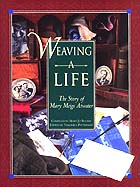
Weaving a Life - The Story of Mary Meigs Atwater
compiled by Mary Jo Reiter
7 x 9 1/4" Softcover (208 pages)
1992, Interweave Press
Once you have started reading this book, I promise you won't be able to put it down. The life of Mary Meigs Atwater (1878 -1956) makes for fascinating reading, and whether you are a weaver or not, you will be caught up in her adventures. Yes, she was the "dean" of American handweaving and truly dedicated to the cause, but she was so much more: artist, world traveler, writer, publisher, chronicler of life in mining camps, wife, mother, occupational therapist, keen observer of people, places and to top it off, a beaver rancher!
The first part of the book contains Mary's autobiography that she wrote when she was in her 70's. Her words literally sing, and her astute sense of humor shines. The remaining one-fourth of the book is a biography, and although Mary's journal and letters to family and friends are cited, I missed Mary's own voice. She was an absolutely incredible woman and this book also includes 16 pages of black & white photographs.
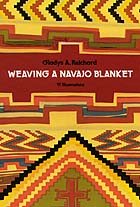
Weaving a Navajo Blanket
by Gladys A. Reichard
5 1/2 x 8 1/4" Softcover (222 pages)
1974, Dover Publishing, Inc.
The author spent four summers (1930-33) living and working among the Navajos, during which time she learned among other things the principles of weaving. In this book she takes the reader through the same process, introducing the careful details, tire personalities she worked with, and the materials and methods of weaving in the Navajo style.
The spinning of the yarn, the dyes, the equipment, the weaving processes, the designs and colors, even the tensions and textures of the final product are all part of weaving a Navajo blanket. In this book, the author takes you through each step, front the choosing of the wool, through carding and spinning warp and weft yarns, building and setting up a loom, creating a design and carrying out the actual weaving. While the emphasis is on typical blanket weaving, the author also covers the related arts of saddleblanket weaving, warp weaving, scalloped edge weaving, double-faced weaving and sandpainting tapestries. She also comments on history, patterns, symbolism, the effect of the market, and other matters that affect the Navajo weaving style. In five appendices she reviews the implements and materials of weaving, Navajo materials for natural dyes, weaving terms, and simple lessons in learning to weave a Navajo blanket. 97 photographs and line drawings illustrate the processes and finished work.
Craftsmen, whether they want to start from scratch or gradually add Navajo elements to their other weaving skills, will learn from this book the authentic steps of Navajo weaving. Collectors, ethnologists, and others will learn more about materials, techniques and related matters that will help them in judging, appraising, and enjoying the processes that go into weaving a Navajo blanket.
This is an unabridged republication of the original 1936 edition of this book, formerly titled Navajo Shepherd and Weaver. There are 97 illustrations throughout.
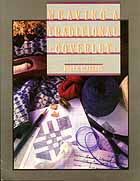
Weaving a Traditional Coverlet - A How to Book
by Helen N. Jarvis
8 1/2" x 11" Softcover (98 pages)
1989, Interweave Press, Inc.
To create a perfect traditional coverlet is the apex of many weavers' dreams. Whether reproducing a historical coverlet for the local museum or designing a new one to become a family heirloom, you'll want to know how to plan the design, choose appropriate materials, weave it skillfully, and finish it well. Weaving a Traditional Coverlet helps you do all that and more. The step-by-step approach will reassure even the weaver of modest skills that a beautiful coverlet, on the first try, is not only possible but attainable.
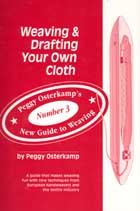
Weaving & Drafting Your Own Cloth
by Peggy Osterkamp
7 1/2" x 10" Spiralbound Softcover (267 pages)
2005, Lease Sticks Press
$54.95 Canadian ($45.95 US)
This is the long awaited third book in series that is focused on the weaving process itself.
The third book in Peggy Osterkamp's New Guide to Weaving series, Weaving and Drafting Your Own Cloth, guides the reader through every step of the weaving process. While it is an excellent book for beginning weavers, experienced weavers will want to keep a copy of this by their loom as a very handy reference book. Unlike other books that mention some problems that can occur when weaving, this book is an exhaustive analysis of potential problems, explaining why and when they can occur and then suggesting solutions for dealing with them. As well as an extensive chapter on troubleshooting, potential problem areas are discussed throughout the book.
Like the other books in the series, the many very consise line drawings included support the author's clearly written explanations eliminating any confusion the reader may have when comparing the information in the book to how the technique or problem would apply to their current project.
The book is well organized and is broken down into chapters titled "Preliminaries", "Weaving", "Shuttles and Winding Bobbins, Pirns and Balls", "Selvedges", "Troubleshooting: When you Begin Weaving", "Troubleshooting: Broken Warp Threads", "Troubleshooting: When Weaving Along", "Finishing", "Drafting", "Drafting: Fabric Analysis" and "Drafting: The Basics of Multi-shaft Weaving". The extensive 17 page index makes specific items easy to find and the book also includes a bibliography and list of suppliers.
The drafting chapter explains how to create your own designs as well as to use drafts in books and magazines. It is written for novice and experienced weavers and teachers, and especially for those weavers who think that they will never understand drafting.
While this book should be in every weaver's library, it and the other books in this series are especially useful for anyone learning how to weave on their own without benefit of an instructor.
The author has also written Warping Your Loom & Tying on New Warps, Weaving for Beginners - An Illustrated Guide, Winding a Warp & Using a Paddle and has produced the video Warping the Loom Back to Front.
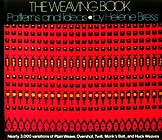
The Weaving Book - Patterns and Ideas
by Helene Bress
11" x 9 3/4" Hardcover (548 pages)
2010, Bress Printing
Nearly 3,000 variations of Plain Weave, Overshot, Twill, Monk's Belt and Huck Weaves
In a single, beautifully illustrated volume, The Weaving Book explores thousands of variations of five of the basic weaves - plain weave, twill, overshot, monk's belt, and huck. With a concentration on four-harness weaving, each of the basic weaves is first shown in its simplest forms and then in both lesser-known and new variations, providing mearly 3,000 patterns in detailed photos, drafts, and treadling orders.
The plain-weave chapter includes a substantial section on warp- and weft-faced effects and log cabin and colour effects, as well as basketweave, spaced warps, and the use of texture. Twill variations include the usual straight, point, and broken treadlings, plus some treadlings such as sunburst, honeycomb, huck, lace, and extended instructions are included for undulating twills, the Indian saddle blanket weave, and Krokbragd. There is a step-by-step guide to understanding twill in its multiple-harness form.
Overshot early American coverlet motifs and some of their variations are clearly charted, and how the motifs may be used in traditional and contemporary ways is shown. How to enlarge and miniaturize patterns, design drafts, and weave patterns in the standard as-drawn-in way - as Spetsvav, as boundweave, in lacy ways, in echo fashion - and more are also shown. Fascinating multi-harness versions of overshot are discussed.
Monk's belt is shown in four distinct ways that permit greater designing freedom. The theme-and-variations approach follows monk's belt through boundweave, petit point, a large variety of honeycomb ways, lacy ways, mathematical progressions, and more. Huck, a lovely but often neglected weave, is shown in it's standard and not-quite-so-standard spot and lacy forms, its monk's belt-like forms, as swivel, and in a multitude of other ways. Completely unique and valuable are the directions for extending huck to its luxuriously beautiful multiple-harness form.
No other volume on weaving contains as vast an assortment of weaving patterns as The Weaving Book. It will provide thousands of ideas for both intermediate and advanced weavers. Illustrated with both colour and black and white pictures and threading diagrams.
Other books by the author include: Inkle Weaving.
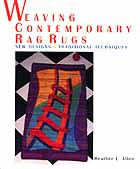
Weaving Contemporary Rag Rugs - New Designs - Traditional Techniques
by Heather L. Allen
10 1/4" x 8 3/4" Softcover (128 pages)
1998, Lark Books
Weaving rag rugs is an immensely satisfying process that enables you to use cast-off remnants of fabric - and a favorite old shirt or two - to make something beautiful and functional for your home. In this book, you'll explore the fascinating history of rag weaving, learn how to weave a basic rag rug, master some of the most popular traditional designs, and experiment with contemporary techniques for weaving and embellishing rugs. Filled with scores of colour photographs of rugs by more than 40 artists from around the world, this book is a delight for weavers and non-weavers alike.
Weaving with rags developed out of genuine necessity centuries ago, when cloth was so highly treasured that it was often unwoven in order to reuse the thread. Although fabric is now commonly available at very low cost, weaving rag rugs remains an especially satisfying process. Transforming fabric remnants and old articles of clothing into beautiful, functional rugs yields a wonderful feeling of accomplishment, and it instills a sense of connection with history and tradition. The basics of rag rug weaving have remained the same over the years, but the materials, designs, weave patterns, and color combinations have changed significantly. Today's weavers have access to an abundant array of warp and weft materials, with a wide variety of fiber content, color, and pattern. There are few-if any-limitations on what you might incorporate into your design: plastic shopping bags, bread wrappers, nylon stockings, and industrial castoffs have all been included. In this book, you'll find the old and the new, traditional designs and contemporary approaches. Starting with a basic, plain-weave rug, it describes the materials and tools you'll need, how to prepare your warp and weft, how to dress the loom, and how to weave with a rag weft. Then you'll learn how to make more complex designs: stripes and plaids, block patterns, reversible designs, inlay motifs, tufted weaves, and many other variations. Applications of surface design techniques, such as immersion dyeing, screen printing, and painting with textile inks, are also explored. In the chapter on design, you'll be guided through the process of choosing colors and deciding upon compositions for your rugs. You'll also find several options for finishing your rug, from traditional braided fringe to a crisp, clean Damascus edge. Once you feel comfortable with the basic techniques, you'll want to sample the rag rug projects. There are a dozen in total, ranging in style from a subtle gradation of stripes to a vibrant tapestry inlay. You'll find seaside motifs and square blocks, pale pastels and brilliant jewel tones. There is even a double weaving project chenille "caterpillars" are woven first, and these become the weft in a wonderfully textured chair pad. Each project is described in complete detail and accompanied by a weaving draft. Throughout the book are full-color photographs of works by more than 40 artists from a dozen countries around the world. These images, together with how-to photography and detailed illustrations, will instruct you and inspire you to sample new directions in your weaving. A fascinating history of rag weaving complements this glorious collection of contemporary rugs.
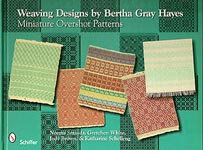
Weaving Designs by Bertha Gray Hayes - Miniature Overshot Patterns
by Norma Smayda, Gretchen White, Jody Brown & Katharine Schelleng
11 1/4" x 8 3/4" Hardcover (158 pages)
2009, Schiffer Publishing
This book features the original sample collection and handwritten drafts of the talented, early 20th century weaver, Bertha Gray Hayes of Providence, Rhode Island. She designed and wove miniature overshot patterns for four-harness looms that are creative and unique.
The book contains color reproductions of 72 original sample cards and 20 recently discovered patterns, many shown with a picture of the woven sample, and each with computer-generated drawdowns and drafting patterns.
Her designs are unique in their asymmetry and personal in her use of name drafting to create the designs.
Bertha Hayes attended the first nine National Conferences of American Handweavers (1938-1946). She learned to weave by herself through the Shuttle-Craft home course and was a charter member of the Shuttle-Craft Guild, and authored articles on weaving.
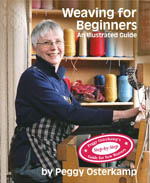
Weaving for Beginners - An Illustrated Guide
by Peggy Osterkamp
8 1/4" x 10 1/4" Spiralbound Hardcover (406 pages)
2010, Lease Sticks Press
$63.95 Canadian ($52.95 US)
The author's newest book provides beginners with the information they need to weave in a clear and enjoyable step-by-step way. Over 600 clear and concise drawings illustrate each step. As her many students have discovered, she inspires confidence in every project.
This is the book students wish for and teachers have been waiting for. Both back-to-front and front-to-back warping are included. There are comprehensive chapters on rigid heddle weaving, computers and weaving, drafting, selvedges, sett, how to plan projects and suggestions for future projects.
The chapter list includes: "Introduction", "Back-to-Front Warping", "Weaving the Sampler", "Finishing", "Front-to-Back Warping", "Drafting", "Computers and Weaving", "Future Assignments", "Sett", "Planning a Project", "Selvedges", "Troubleshooting", "Rigid Heddle Loom", "Knots" plus a list of Sources and a very comprehensive 22 page index! Apeendices cover "Hand-manipulated Weaves", "Hemstitching", "Brooks Bouquet", "Chaining V-shaped Stitches", "Twining", "Ghiordes Knot", "Spanish Lace", "Danish Medallion", "Leno", "Opening a Skein", "Peggy's Weaving Apron", "Needle Case" and "Sett Charts".
The authors other books include: Warping Your Loom and Tying on New Warps, Weaving & Drafting Your Own Cloth, Winding a Warp and Using a Paddle and has produced the video: Warping the Loom Back to Front.
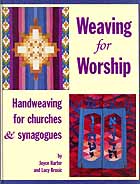
Weaving for Worship - Handweaving for Churches & Synagogues
by Joyce Harter and Lucy Brusic
11 1/4" x 8 3/4" Hardcover (158 pages)
1998, Robin and Russ Handweavers, Inc.
This book is for everyone involved in the use and creation of liturgical textiles. It contains useful chapters on the theory as well as the practice of liturgical weaving and is designed to inform art committees in synagogues and churches as well as weavers and collectors of liturgical art. All the writers are experienced weavers who share a great wealth of practical and theoretical information.
Whether you are a: textile artist working for churches or synagogues, a collector who wants to understand the rich tradition behind liturgical textiles of the Jewish and Christian faiths, a member of a church or synagogue seeking to commission work for a sanctuary or a worshipper who wishes to understand the richness of the textiles in the worship environment, then Weaving for Worship was written for you!
The Beautiful colour plates will inspire you. The text will increase your appreciation of the religious traditions behind the use of textiles. Numerous patterns and drawings will guide you to design and weave textiles that truly enhance worship settings.
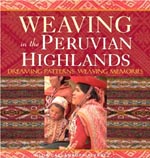
Weaving in the Peruvian Highlands - Dreaming Patterns, Weaving Memories
by Nilda Callanaupa Alvarez
8 1/2" x 9" Hardcover (96 pages)
2007, Interweave Press
Handwoven fabrics comprise the living history and culture of the Peruvian highlands from Cusco to Machu Picchu and beyond. Fabric patterns with evocative names reflect the landscape and events in vivid color, evolving over time.
The weavers who create these fabrics in the time-honored way are keepers of the culture and sustainers of a noble but difficult lifestyle in tune with the earth. They raise llamas and alpacas for fiber, collect plants for natural dyes, spin yarn on primitive spindles, and weave acres of cloth on simple backstrap looms just as their forebears have done for thousands of years. They weave clothing, rugs, bedcovers, potato sacks, hunting slings, and sacrificial fabrics - for themselves and their villages, and for sale to supplement their meager incomes.
Travellers visiting the area (hundreds of thousands a year from North America alone) are drawn to this authentic, well-crafted work and given the opportunity to collect it at every street corner and rail stop. Weaving in the Peruvian Highlands is their guide to quality, understanding, and appreciation. They will learn how pattern names such as "Meandering River" or "Lake with Flowers" relate to the geography and history, and how the traditional natural materials and colors enhance the value of the work.
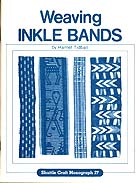
Weaving Inkle Bands
by Harriet Tidball
8" x 10 1/2" Softcover (40 pages)
1969, The Shuttle Craft Guild
This is Shuttle Craft Monograph Twenty-Seven and provides an in depth guide to weaving with Inkle and Rigid Heddle looms with the intent of producing Inkle Bands, The history of the Inkle Loom, instructions on how to build a board loom and sections comparing the English, American and other Modern Inkle Looms are provided before the author gets into instructions on how to warp up the loom. After discussing the yarn, colour patterns, drafts and weft variations, it is on to discussions on Variations, Embellishments and Finishes with short chapters on Picots, Ghiordes Knot Fringes/Tassels, Fringes, Inkle-Fringe Warp, Slits and Divisions, Tubular Inkles, Added Decorative Items, and Widening/Narrowing Bands. Various Pick-up techniques are described including: Cross-Barred, Diamond Background, Geometric Style, Brocade and Supplementary Warp Patterning. The author then finishes with chapters that discuss various uses for Inkle Bands, How to join them and Finishing Techniques.
Click Here for a full list of the Shuttle-Craft Guild Monographs currently available.
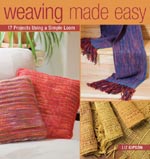
Weaving Made Easy - 17 Projects Using a Simple Loom
by Liz Gipson
8 1/2" x 9" Softcover (127 pages)
2008, Interweave Press
$30.95 Canadian ($25.95 US)
Weaving Made Easy is the beginning weavers' ultimate guide to making fun, simple, and functional weaving projects from start to finish. It features seventeen simple projects made on the rigid heddle loom, a small, portable, and affordable weaving loom.
The book includes a step-by-step guide on getting started weaving; weaving vocabulary 101, tools and materials explained, the basics of warp and weft, and how to start weaving. Clear instructions are provided for how to make various practical fabrics, from drapy to sturdy scarves and bags to belts, placemats, rugs, and more.
The projects in this book are: "Fully Loaded Scarf", "Cozy Coasters", "Bobbled Slippers", "Color-Play Plaid", "Two-Skein Scarf", "Piping Hot Pillows", "Layered Cravat", "Tweed So Fine", "Grab it and Go Bag", "Pleasing Proportions Bag", "Bamboo Obi", "Loopy Mats", "Simply Striped Rug", "Pick-up Belt", "Space-Saving Mats", "Leno Runner" and "Brooks Bouquet Shawl".
Weaving Made Easy includes an abundance of tips and techniques for color, design, construction, and embellishment in weaving. With clear, concise step-by-step photographs and instructions, this is the ideal book for beginning weavers.
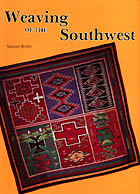
Weaving of the Southwest
by Marian Rodee
9" x 12" Softcover (248 pages)
1987, Schiffer Publishing
$35.95 Canadian ($29.95 US)
This new and gorgeously-illustrated book presents important information on Pueblo, Navajo, Rio Grande and Northern Mexican weaving styles of the Southwestern U.S. region. Traditional and modern styles of blankets, clothing and rugs are identified and explained in detail with brief accounts of some of the old trading posts that sold them. Unique to this book are discussions of family styles with active weavers today. The author continues to work with modern weavers interested in preserving old styles and has gained personal insight to the origins of both old and new designs which she shares, for the first time, with her readers.
The illustrations are drawn largely from the famous and outstanding collection of southwestern weavings at the Maxwell Museum of Anthropology at the University of New Mexico where the author has been curator for many years. She knows these weavings well and clearly explains them. 194 colour plates and 385 black & white pictures present these outstanding weavings clearly for close inspection. All weavers, collectors, dealers and historians will welcome this new study.
Marian E. Rodee is the Curator of Collections at the Maxwell Museum of Anthropology, University of New Mexico in Albuquerque. She has worked closely with contemporary weavers in recent years who have studied the old designs carefully. Her interest is in perpetuating the native skills into the new generation.
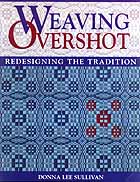
Weaving Overshot: Redesigning the Tradition
by Donna Lee Sullivan
8 1/2" x 11" Softcover (160 pages)
1996, Interweave Press, Inc.
Donna Lee Sullivan has spent years exploring the intricate design possibilities of overshot weaves. This book presents the fruits of her explorations - the reading she's done, the workshops she's taken, the designs she's created at her computer, and the experiments she's made at her loom.
Beginning with the basics of overshot, the author leads the reader one simple step at a time from traditional "colonial" four-shaft patterns to designing and drafting overshot, combining overshot with threadings for other weave structures, working with more than four shafts, analyzing and reproducing antique fabrics, and reading antique drafts. Each technique is clearly and sensibly presented with drafts, woven samples, and easy-to-follow instructions so that the beginner weavers will be assured of success and experienced weavers will be inspired by the many possibilities of this versatile weave structure.
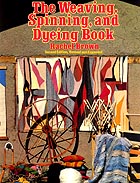
The Weaving, Spinning, and Dyeing Book - 2nd Edition Revised & Expanded
by Rachel Brown
9" x 11 1/4" Softcover (430 pages)
2000, Alfred A. Knopf, Inc.
This book provides a wonderful overview on weaving, spinning and dyeing giving the reader a start to finish understanding on the complete process not found in other books that focus on a specific aspect of fibre arts. Diagrams are used extensively to illustrate concepts and to explain how-to-do-it for almost every step in the journey from raw materials to fabric. This book has been completely updated and includes a revised and expanded list of suppliers.
The contents include topics such as card weaving which include how to use (and in some cases, build) the inkle loom, Hopi belt loom, backstrap loom, Navajo loom and the treadle looms (counterbalanced, countermarche and jack) as well as how to set up and weave on each. In sections on weaving methods, equipment and tools, everything you need to know about choosing yarns as well as finishing techniques including fringe (twisted, braided, knotted and macrame), tassels, feathers, rope, edges, pressing and joining.
In another section, the author describes a master plan for designing, planning, executing and finishing a weaving project. It enables absolute beginners to create their own beautiful work and provides countless tips and unorthodox techniques for experienced weavers. On the subject of spinning, everything about spinning from picking a good fleece and cleaning the wool to teasing, flicking, types of hand spindles; all about different wheels (the high wheel, the flyer wheel and homemade wheels), choosing spinning equipment, yarn design and function are covered.
In sections on dyeing: natural vs. synthetic dyes, obtaining dyestuffs, equipment and recipes for dyes are described. The book includes information on design and colour including: uniformity vs. variation, repetition, scale and interest, backgrounds, balance, proportion, properties of colour, understanding hue, intensity and value.
To provide ideas on how to apply the skills, more than 50 weaving projects (with complete instructions) ranging from the simple to the complex, including belts, sashes, stoles, ponchos, handbags, wall hangings, pillow covers, tapestries, rugs, throws, blankets, a bedspread, a room divider, 3-dimensional weaving, etc. are included.
Finally the author talks about pricing your work and selling it (to private buyers, at fairs, in shops or galleries), entering exhibitions and running your own retail or wholesale business. With names and address of suppliers for yarns, weaving equipment, spinning equipment and dyes all over the world. The Weaving, Spinning and Dying Book is thoroughly practical book that instructs and inspires. The book includes 432 explicit and beautiful drawings as well as 19 colour photographs.
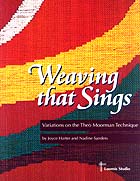
Weaving that Sings - Variations on the Theo Moorman Technique
by Joyce Harter & Nadine Sanders
8 1/2" x 11" Softcover (96 pages)
1994, Loomis Studio
Theo Moorman referred to the Moorman technique as "a gateway through which weavers can pass to other fields". A gateway is exactly what Joyce Harter and Nadine Sanders have provided for us in Weaving that Sings. The reader not only learns about the technique, but also how to design to suit the structure. A smooth writing style, clear illustrations, and exciting photographs make it easy to grasp the variety of concepts presented. A gallery of other artists' work adds the exciting dimension of various innovative approaches, which encourages one to begin designing, right now!
This work adds to the current explosion of interest in Theo Moorman and her special inlay technique. In addition to classic Moorman inlay, the book demonstrates layering and texturing techniques for a firm, opaque fabric, outline principles and steps for successful design, and gives special warping and weaving tips. One chapter is devoted to designing garments in Moorman technique and another to designing and "weaving double warp overlay" rugs that show curved designs on one face and striped designs on the other. Beginning and experienced weavers alike will find inspiration from the many black and white and colour photographs of contemporary pieces and the heartfelt tribute to Theo Moorman from the artists.
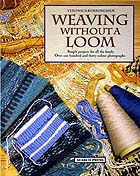
Weaving without a Loom
by Veronica Burningham
8" x 10 1/4" Softcover (64 pages)
1999, Search Press
Create beautiful woven tapestries and hangings, bags and belts, shawls and hats, mobiles and dream catchers - all without a loom! Learn how to master simple weaving techniques which illustrate how to combine texture and colour using sticks, card, hardboard, picture frames and rings. Over 130 colour photographs and easy-to-follow instructions guide the reader through a range of simple, inexpensive projects suitable for all the family.
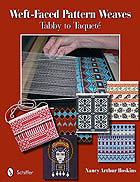
Weft-Faced Pattern Weaves - Tabby to Taquete
by Nancy Arthur Hoskins
8" x 11 1/2" Spiralbound Softcover (336 pages)
2012, Schiffer Publishing
Back in Print!
This is the definitive work on weft faced pattern weaves. Travel beyond the traditional limits of boundweave with this comprehensive text that teaches beginning or experienced weavers how to plan, predict, and weave colorful, rhythmical patterns, charming folk figures, and geometric designs in fabrics that are decorative and durable.
The book begins with an examination of the structural similarities of weft-faced pattem weaves, and ends with an homage to their antiquity with replicas of three thousand year old patterns from textiles found in Coptic and Ancient Egypt. Following this, there are 53 lessons in the book, organized around one or more samplers, that progress from a simple two-shaft weave suitable for a rug to a sophisticated sixteen-shaft samitum in luxurious silk.
This text is a study guide on the weft-faced weaves for novice or experienced individuals or groups in the studio, workshop or classroom. If the reader can read a threading draft and dress a loom they will be able to follow the directions in this book. Once the reader has woven the pick and pick pattern is the first sampler they will have learned the basic principle involved in weaving all weft-faced patterns. The fundamentals are included for beginners, and the advanced weavers will find some challenging lessons for multi-shaft looms.
There are 63 Samplers illustrated in colour or black & white with Threading, Tie-up, Treadling and Drawdown information. Of these, 26 of them are for four-shaft looms with threadings based on plain weave, twill, point twill, rosepath, overshot, and taquette. There are 30 samplers for eight-shaft looms based on twill, point twill, taquette (weft-faced compound tabby) and samitum (weft-faced compound twill). The remaining 7 samplers are re-creations of weft-faced patterns from Coptic and Ancient Egypt on five, seven, ten, fifteen or 16 shafts some woven with the dobby of computer-assisted loom. This book contains an extensive amount of information and includes 400 Figurative, Floral, Flamepoint and Geometric patterns. This book is well illustrated and an extensive Bibliography and Index is also included.
The author has also written Universal Stitches for Weaving, Embroidery and Other Fiber Arts and is the instructor in her Boundweaving video.
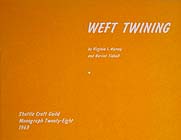
Weft Twining
by Virginia I. Harvey & Harriet Tidball
10 1/2" x 8" Softcover (39 pages)
1969, HTH Publishers
$11.95 Canadian ($9.95 US)
This is Monograph Twenty-Eight from the Shuttle-Craft Handweavers Guild
A joint effort by two master weavers, this book explores weft twining, both from a historical and technical perspective. The basic structure is covered along with variations and the use of twining both historically and in contemporary life provides information on its relevance today. In the historical section the authors discuss twining in Peru, the Chilkat Blanket, the Maori of New Zealand and the Nagas of Northeast India. After covering different loom types, they proceed into a fairly lengthy analysis of the structures of weft twining and finish off with a good bibliography on the subject. This is a great book, filled with line drawings showing the techniques and black & white photographs showing the finished work.
Click Here for a complete list of the monographs in the Shuttle-Craft Guild series.
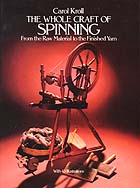
The Whole Craft of Spinning - From the Raw Material to the Finished Yarn
by Carol Kroll
8 1/4" x 11" Softcover (47 pages)
1981, Dover Publishing, Inc.
The ancient craft of spinning is becoming increasingly popular with today's modern craft enthusiasts as it provides a method of creating unique, personal and unusual yarns that can be used in contemporary weaving, knitting, crocheting, needlepoint, embroidery and macram6. It is a highly creative craft, yet simple to learn, and therein lies both its fascination and challenge.
The story of spinning is interwoven with the history of man. The first attempt at spinning probably consisted of twisting animal fibers with suitable plant material. Some forms of hand spinning existed as early as 15,000 years ago in Asia, and 12,000 years ago in North Africa. Many of the earliest methods and tools are still in use to this day, especially the various drop spindles, and the Indian and Navajo types of spindles. The spinning wheel itself is believed to have evolved in India 800 to 1,000 years ago.
Now you can master this timeless craft through the clear instructions and easy-to-follow directions of well-known spinning authority Carol Kroll. Drawing upon her years of valuable experience, the author shows you everything you need to know from set-up to finished product. You'll learn about the different kinds of spindles and spinning wheels, their history, development,' and modern applications. Her lucid text deinonstrates the proper methods of preparing the fiber for spinning including: selecting the fiber, sorting, washing, adding oil, and carding.
Whether you're a novice or an experienced hand, Carol Kroll's expert advice shows you the ins and outs of: Spinning with a Drop Spindle, Finishing the Yarn, Spinning with Wool and Other Animal Fibers, Making Your Own Spindle, Spinning on a Treadle Wheel, How to Shop for a Spinning Wheel, Making the Most of Natural and Synthetic Fibers and The Fun of Creating Novelty Yarns.
This book also includes an access and resources section with suggested further reading, supplies, services, and much more to get you started making something that is truly your own, from the first step to the last.There are 33 illustrations which include both black & white photographs as well as line diagrams.
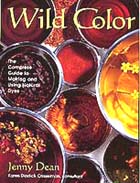
Wild Color - The Complete Guide to Making and Using Natural Dyes
by Jenny Dean
7 3/4" x 10 1/2" Softcover (144 pages)
1999, Watson-Guptill Publications
Crafters who value working with environmentally friendly materials will appreciate the expert guidance in this clear guide to growing and using plants to make exquisite dyes in a broad range of colors.
Demystifying the process, the book answers all the questions asked about using natural dyes, helping readers to avoid commonly encountered pitfalls. More than sixty plants that can be grown widely are discussed, with complete information on how to cultivate and work with them in extracting dyes. This collection can be used to create a broad range of colors.
Clear and simple explanations of techniques are accompanied by helpful, step-by-step photographs. A practical ring-bound format features a separate section of color swatches cross-referenced to the best dye plants to achieve each hue.
The book is well photographed and includes how-to sections, excellent history of dyeing, beautiful photos of the various dyestuffs, and a symbology to really track the technique and possibilities as you study the various International dye sources make this an excellent dyeing book.
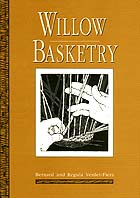
Willow Basketry
by Bernard and Regula Verdet-Fierz
7 1/4" x 10 1/4" Hardcover (355 pages)
1993, Interweave Press
Experience the satisfaction of working willow into beautiful and classic forms - and become part of a great tradition.
Here's a rare opportunity to learn traditional European willow basketry techniques under the guidance of two master craftsmen. Bernard and Regula Verdet-Fierz of Switzerland have written and illustrated a handbook to provide aspiring and experienced basketmakers with access to a wealth of traditional forms and techniques. The present their well-grounded approach to working willow with the thorough apprenticeship style they use in their own workshop.
In the opening chapters, you'll find information on the shop, the tools, the cultivation and harvesting of the willow plant, the processing of rods, weave patterns, basket design and construction techniques. The handsome, informative, step-by-step illustrations carefully guide you through the process of learning.
The authors also offer full instructions for making eight Old World basketry projects -- a shopping basket, lidded basket, tray, laundry basket, stool and more. You'll learn enough about how to plan a project and work the materials to create your own variations on round, oval and squarework forms. There are also an extensive glossary, bibliography and index, as well as a list of willow and basketry sources in the United States, Canada and Europe. First published in German, this valuable information is being presented for the first time to English-speaking basketmakers.
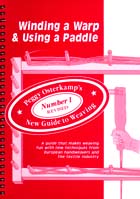
Winding a Warp & Using a Paddle - Revised Edition
by Peggy Osterkamp
7 1/2" x 10" Spiralbound Softcover (135 pages)
1998, Lease Sticks Press
$47.95 Canadian ($39.95 US)
This is the first book in Peggy Osterkamp's New Guide to Weaving series.
All weavers know what a tedious, but important part of the weaving process winding on a well-prepared warp is. The abundance of information for doing this task in the techniques laid down by our forebears will make this book a classic in weaving literature. Learn how to use several styles of paddle to design and wind warps as you go. Follow the detailed advice and sidebars throughout - if not on this warp, the next.
The author starts with a brief introduction on looms and weaving and then describes the tools of warping in a chapter on "Equipment" which covers Warping Mill/Reels, Creels, Tension Box, Paddles and Raddles. This is followed by chapters called "Your Warp's Path", "The Raddle Groups", "Warping" and "Securing the Warp" which take the reader through the warping process removing the mystery and providing many hints. After explaining the "Kitestick", the author explains how to use a Raddle and various types of Paddles. A very good chapter on calculating Sett with various yarn types and combinations explains the mathematics involved and the final section entitled "Planning the Project" takes the reader through the whole process and provides a set of worksheets to use. The book's Appendix includes 14 pages of useful Sett tables and formulas and a large complete index makes finding specific topics very easy. The highlight of this book are it's many very, very clear illustrations that complement the author's text to each of the processes. If you have ever struggled through the warping process, this book provides an excellent tool to make warping easy.
The instructer has also written Warping Your Loom & Tying on New Warps, Weaving & Drafting Your Own Cloth, Weaving for Beginners - An Illustrated Guide and has produced the video Warping the Loom Back to Front.
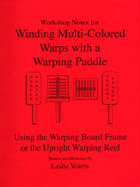
Winding Multi-Colored Warps with a Warping Paddle
by Leslie Voiers
8 1/2" x 11" Spiral Bound Softcover (32 pages)
2001, Water's Edge Weaving Studio
The warping paddle is the key to the considerable timesavings when winding a warp, whether it be of all one colour or multiple color-stripe design unit. Not only does it offer a painless alternative to winding a repetitive multicolored stripe pattern, it even saves a considerable amount of time. The author has produced a wonderfully clear "how-to" guide to using a warping paddle with a warping board, warping mill and/or bobbin rack.
This document was created as a compilation of notes, illustrations and drafts that form the handouts for the author's workshop on Warping Paddle use. Crisp, clear diagrams and handy tips coupled with explanatory text help the reader understand how to use this timesaving tool.
Other monographs by Leslie Voiers include: Conversation & Notes on Log Cabin, Lace Weaves Portfolio and Plain Weave is Anything but Plain.
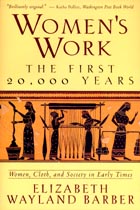
Women's Work - The First 20,000 Years
by Elizabeth Wayland Barber
5 1/2" x 8 1/4" Softcover (334 pages)
1995, W. W. Norton & Co.
Twenty thousand years ago, women were making and wearing the first clothing created from spun fibres. In fact, right up to the Industrial Revolution the fibre arts were an enormous economic force, belonging primarily to women.
Despite the great toil required in making cloth and clothing, most books on ancient history and economics have no information on them. The extreme perishability of what women produced is largely responsible for this omission - a gap that leaves out virtually half the picture of prehistoric and early historic cultures. But today's new discoveries about the textile arts are revealing women's vital role in pre-industrial society.
Elizabeth Wayland Barber has drawn from data gathered by the most sophisticated new archaeological methods - methods she herself helped to fashion - to show that women were a powerful economic force in the ancient and early modern worlds, with their own industry: fabric. Alternatively titled Women, Cloth and Society in Early Times this book is a wonderful study on the subject filled with many drawings and an extensive index and list of sources.
This author has also written The Mummies of Urumchi.
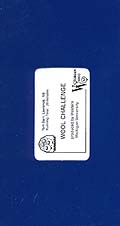
Wool Challenge
Western Michigan University
Video (20 minutes colour)
Victorian Video Productions
$22.95 Canadian ($18.95 US)
This documentary is perfect for young children, schools, libraries, museums, and weaving/handcraft shops as it thoroughly describes the process of transforming the raw wool into a woven garment. You'll see the entire process from shearing the sheep, to spinning the wool, warping the loom, weaving, washing the fabric, and constructing a garment. An informative and enjoyable video.
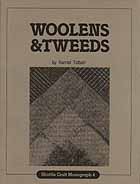
Woolens & Tweeds
by Harriet Tidball
8" x 10 1/2" Softcover (46 pages)
1961, ShuttleCraftBooks Inc.
$12.95 Canadian ($10.95 US)
This book focuses on Wool analyses the production of fabric all the way from the fibre itself, through the fleece and spinning to weaving and finishing. Design of Woollen and tweed fabric is covered along with many samples and patterns. This is the Shuttle-Craft Guild Monograph Number 4.
Click Here for a full list of the Shuttle-Craft Guild Monographs currently available.
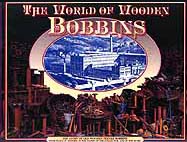
The World of Wooden Bobbins
edited by Graham Fellowes
9" x 11 3/4"Softcover (80 pages)
1995, The Discovery Collection
Bobbins are the children and grandchildren of some of the greatest inventions of the Victorian Era in America and England, and we can hold these little treasurers in our hands, own them and enjoy them today. Read how to find, identify and preserve them. These artifacts from the textile mills have an amazing story to tell... and here it is... against the backdrop of hundreds of illustrations.
Follow the thread... from the humble home-based spinner working by the fireside to the emergence of the great textile mills employing thousands. Pictures let us glimpse at how it developed and where and how wooden bobbins played their part.
Using over 300 pictures in colour and black and white, this fascinating book provides a history of the development of industrial weaving with an extensive guide to the many types of bobbins, looms and shuttles in use during the 18th to 20th century. A must-have for any bobbin collector and/or weaver interested in knowing more about the history of weaving in North America and Europe
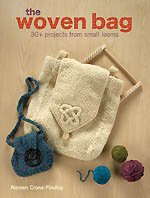
The Woven Bag - 30+ Projects from Small Looms
by Noreen Crone-Findlay
8 1/4" x 11" Softcover (128 pages)
2010, Krause Publications
$30.95 Canadian ($25.95 US)
Try small loom weaving and get big results!
The Woven Bag features bags in a wide variety of shapes and sizes, from the petite Beaded Amulet Pouch to the voluminous carry-all, The Grand Duchess.
Each bag is created using small looms, such as potholder looms, frame looms and knotted mesh looms. Even if you've never woven before, the tips, tricks and techniques in this book will quickly have you weaving squares, triangles and rectangles that can then be assembled into wonderful one-of-a-kind projects.
The list of projects includes: "Beaded Amulet Bag", "Freindly Elephant Bag", "Felted Honey Bunny Purse", "Lady Marjorie Bag", "Cheeky Monkey Bag", "Sock Monkey Bag", "Sweethearts Pouch", "Heart's Treasure Zippered Pouch", "Multipurpose Pouch", "Business Card Envelope", "ID Badge Holder", "Butterfly and Chevron Bag", "Cheerful Cherry Tote", "Felted Nine-Patch Bag", "Harlequin Purse", "Origami Clutch", "Felted Heart Bag", "Elegant Edgings Bag", "Happy Dancer Bag", "Xs and Os Clutch", "Woven Roving Posy Bag", "Knotted Fabric Market Bag", "Upcycled Market Carrier", "Full Circle Bag", "Furoshiki Bag", "Patchwork Princess Tote", "Semicircular Hobo Bag", "Tandem Market Tote", "Surf's Up Beach Bag", "Celtic Knot Backpack", "The Grand Duchess" and "Knitting Pretty Bag".
Inside The Woven Bag, you will find step-by-step instructions for every step of the process, from weaving to assembly; written instructions, including helpful illustrations, for over 30 bags, pouches, totes, purses and backpacks plus a plethora of helpful hints, tips and tricks from author Noreen Crone-Findlay.
Weave your way to a beautiful new bag today!
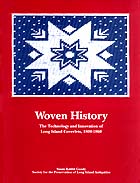
Woven History - The Technology and Innovation of Long Island Coverlets, 1800-1860
by Susan Rabbit Goody
8 1/2" x 11" Softcover (86 pages)
1993, Society for the Preservation of Long Island Antiquities
Textile historian and weaving instructor Susan Rabbit Goody documents a significant aspect of Long Island's material cultural heritage, the double-woven coverlets made during the first half of the nineteenth century. Ms. Goody's study has led to a host of revelations, and has provided a broader understanding of the Long Island Coverlet weavers, their equipment, products and decorative motifs during a period of rapidly changing technology.
With the help of photographs, articles and advertising from this era the author first describes early coverlet production in the Long Island area giving the reader a historical context. Then she inventories and dates coverlets from this area, many of which are then shown in a pictorial "exhibition" of over 50 coverlet designs. This is an excellent book for those interested in historical coverlets and/or who wish to learn something about the weavers who produced these designs. Extensively illustrated in black and white.
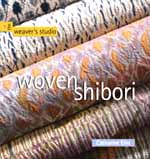
Woven Shibori
by Catharine Ellis
8 1/2" x 9" Softcover (126 pages)
2005, Interweave Press
$41.95 Canadian ($34.95 US)
Catharine Ellis's breakthrough technique - woven shibori - embraces new approaches to the art of weaving and dyeing.
In the traditional shibori technique, stitches are placed into a piece of commercial cloth with a needle, the cloth is compressed, and then dyed. In woven shibori, the "stitches" are supplemental wefts woven directly into the cloth thus becoming a part of the original cloth construction.
The use of the loom to control the placement of these threads has defined a whole new and exciting vocabulary of resist images for weavers, and the integration of cloth construction with surface treatment provides new avenues of expression for textile artists of all skill levels.
Woven Shibori includes thorough instruction in a range of weaving applications, from plain weave and twills to laces. The author provides plenty of fascinating examples and tips, and safely guides weavers through the stages of dye applications. Through breathtaking photography, clear step-by-step instructions, drafts, and dyeing tutorials, weavers will find the process is easy to work with and marvel at the unlimited possibilities. There are 20 color photographs and 48 drafts included in this book.
Catharine Ellis is an artist and teacher who divides her time between studio work and the Professional Craft Program at Haywood Community College in Clyde, North Carolina, where she has been the fiber instructor since 1978. She also teaches at the Penland School of Crafts, and offers workshops internationally. Her work has been featured in Fiberarts, Handwoven, Shuttle Spindle & Dyepot, and Surface Design Journal. Catharine lives in Waynesville, North Carolina.
This is the second book in The Weaver's Studio series focused on artists sharing their know-how and designs. The first book in the series is Rep Weave and Beyond.
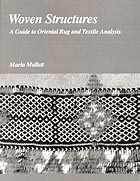
Woven Structures - A Guide to Oriental Rug and Textile Analysis
by Marla Mallett
8 1/2" x 11" Softcover (188 pages)
2000, Christopher Publications
This book is a rug collector's "bible" on matters of structure and process and a source of ideas for any rugweaver wanting to learn from weavers around the world and throughout history. The author describes how textiles are constructed as well as providing meticulously detailed descriptions of knotted pile and flatwoven structures that not only identify weaving techniques but the design characteristics they encourage.
The book evolved out of the author's frustration at not having a reference manual for identifying the origin and classifying woven articles from around the world. This book is designed to provide standard structural analysis of woven rugs, an explanation of basic weaves, and to sort out elemental technical language. Rather than looking at the whole rug at one time, the author focuses on smaller design components identifying each technique highlighting similarities and differences.
After introducing "Common Sense Structural Analysis" and an overview of the basics, the author provides chapters on "Knotted Pile", "Knotting on Warp-Faced Grounds", "Twining", "Soumak", "Tapestry", "Weft-Substitution Weave", "Brocading", "Complementary-Weft Weave", "Warp-Substitution Weave", "Warp-Float Patterning:, "Straps and Bands", "End Finishes", "Assorted Decorative End Borders", "Selvages", "Joins" and "Bag Closures". In each chapter, a large number of finished woven articles are shown along with line drawing explaining the technique used to achieve the effect.
This new revised edition of the original book published in 1976, has clarifications in the text throughout, as well as a few improved illustrations. It contains hundreds of black & white photos and line drawings.
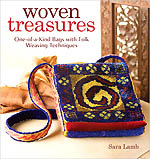
Woven Treasures - One-of-a-Kind Bags with Folk Weaving Techniques
by Sara Lamb
8 1/2" x 9" Softcover (144 pages)
2010, Interweave Press
Renowned fiber artist Sara Lamb gives weavers an inside look at her groundbreaking work in Woven Treasures. From inspiration and project planning, to her signature hand-manipulated techniques, Lamb leads weavers through the steps of making exquisite bags using folk weaving techniques that evoke modern ideas in brilliant colors and textures.
Woven Treasures includes an overview of Lamb's recent bag series; an introduction for the weaver to the process of concepting and planning a woven piece; a technique section of 6 folk weaving tutorials, such as hand-manipulating weaving techniques with a multi-technique sampler that gives basic instructions for soumak, twining, cut pile, cardweaving, inkle weaving, and plain weave. In addition there are project instructions for 7 hand-woven bags plus sidebars sprinkled throughout the book include the history of folk weaving techniques, as well as Lamb's signature beaded and stitched embellishment designs.
Woven Treasure's bag designs allow weavers an immediate sense of accomplishment, and the finished projects can be used and/or displayed as works of art.
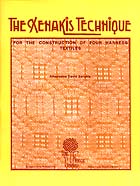
The Xenakis Technique - For the Construction of Four Harness Textiles
by Athanasios David Xenakis
8 1/2" x 11" Softcover (56 pages)
1978, Golden Fleece Publications
This guide is designed to help Rigid Heddle weavers get more out of their loom. The author's technique allows weavers to produce fabric designs with more than 2 harness designs. The production of Plain Weave, Twill, Overshot, Summer & Winter, Bronson Weave and many more designs using the Rigid Heddle Loom are described. The book includes black and white photographs of finished fabrics as well as threading diagrams and instructional aids to help the Rigid Heddle weaver.
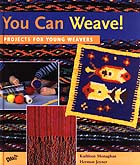
You Can Weave - Projects for Young Weavers
by Kathleen Monaghan & Hermon Joyner
8 1/2" x 10 1/4" Hardcover (96 pages)
2000, Davis Publications, Inc.
$25.95 Canadian ($21.95 US)
Guess What? You Can Weave!
... And you don't have to be an expert weaver to introduce weaving skills to children! You Can Weave! provides illustrated step-by-step projects that build a foundation of weaving knowledge and skills. The projects rely on supplies that are readily available, such as paper, yarn, ribbon, string, rags and beads.
Children can learn and practice basic weaving processes by hand and on cardboard, frame, back strap and other wooden looms. You Can Weave! provides easy-to-follow instructions for building the looms and a rigid heddle. Colourful examples of woven art throughout the book will inspire young weavers.
For further enjoyment and creativity, children can learn the multicultural techniques of weaving beads, braids and baskets. Literary quotations and mythology associated with the art of weaving provide a whimsical touch to the pages of this highly useful reference. A wonderful and fun experience awaits anyone interested in learning to weave.
The 18 projects included in this book are: "Woven Paper Place Mat", "Straw Weaving", "Ribbon Weaving", "Woven Pouch", "Woven Mug Rugs", "Tapestry Picture", "Rug Place Mats", "Rya and Tapestry Sampler", "Balanced Plain Weave Fabric", "Balanced Plain Weave, Plaid", "Balanced Plain Weave, Log Cabin", "Striped Belt", "Ikat Belt", "Nature Weaving", "Woven Seed Bead Bracelet", "Beaded Medicine Pouch Kumihimo Braids", "Beaded Bracelet Basket Weaving" and "Woven Basket". Each project is described in detail, colour photographs show the finished projects and the technique used for each is shown in a series of photographs. An Index, Bibliography, Glossary along with detailed construction information for the looms complete this wonderful book.
|
How to Order: Orders may be placed using our secure Online Order Form (this form should open in another window). Click Here for more information on how to place an order as well as our terms and conditions. Payment/Currency: Payment can be made using VISA or Mastercard, Cheque or Money Order in US or Canadian funds. US credit card purchases are billed directly in US funds eliminating any foreign currency conversion charges by the credit card company. Product Directories If you are looking for other items on our website, try using our product directories to quickly find what you are looking for! Our products are grouped as follows: Weaving/Spinning Product Index Books, Magazines & Videos. |
Price/Shipping Quote? If you would like an exact quote for any items complete with shipping costs, please call or email us at nmanners@camillavalleyfarm.com with you location and we will provide this. Gift Certificate If you are looking for a gift for a Knitter or Weaver and can't figure out what they want, a Camilla Valley Farm Gift Certificate is an excellent way to ensure you get the perfect gift! We can also email gift certificates if you are running out of time! Latest News/Updates Keep up to date with what is new at Camilla Valley Farm by following us on Instagram! (Click on the logo below)  |